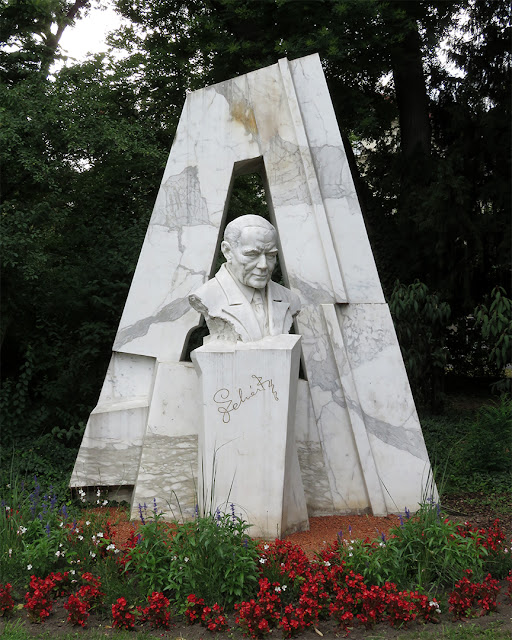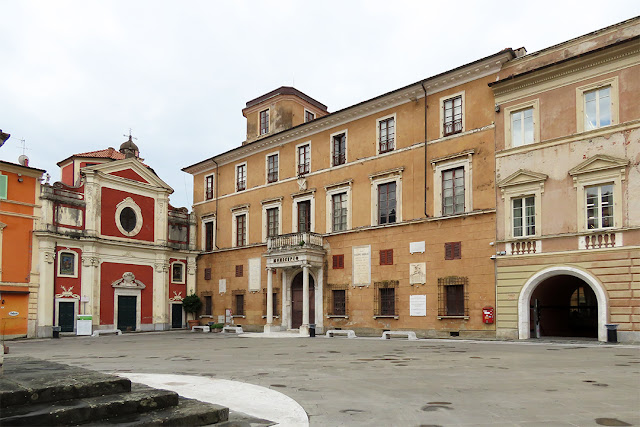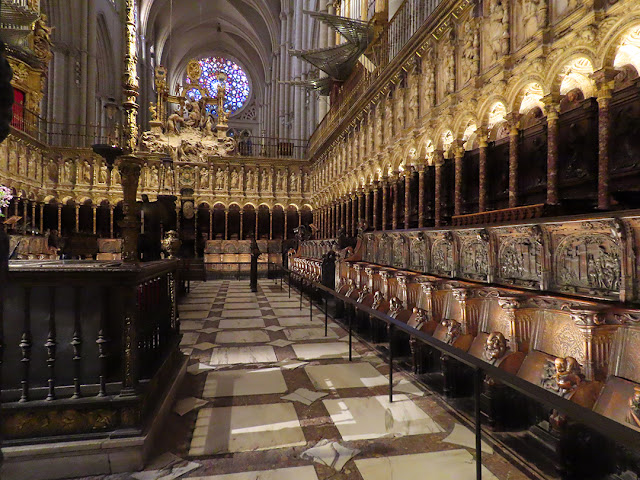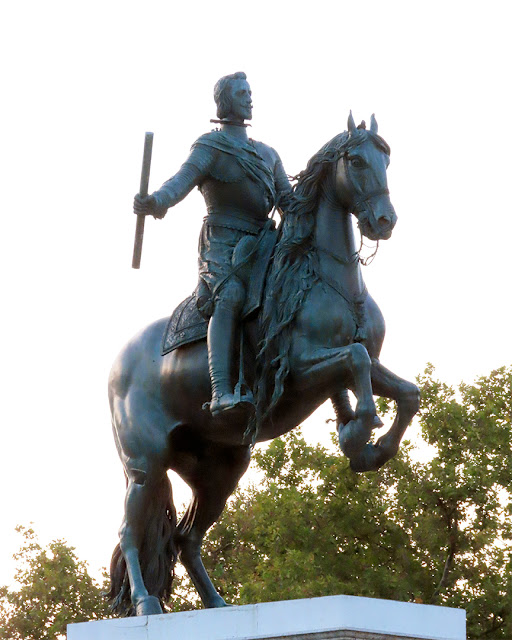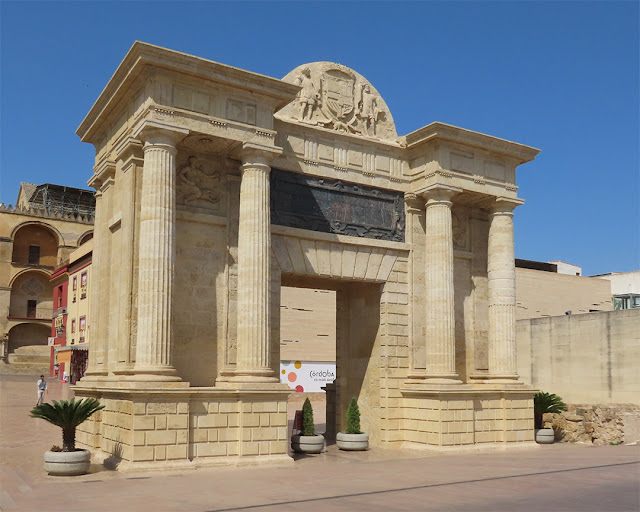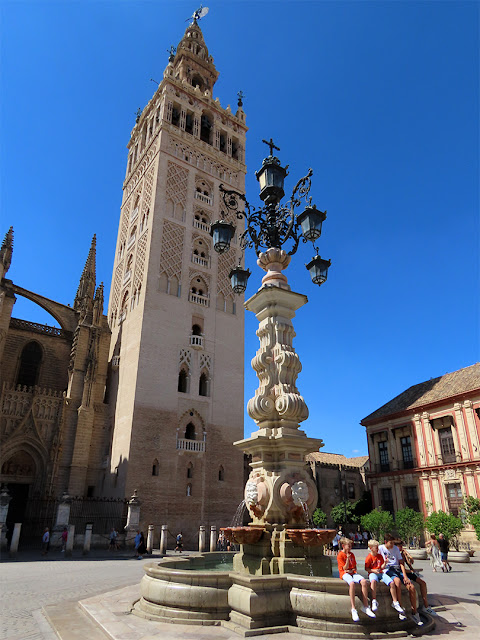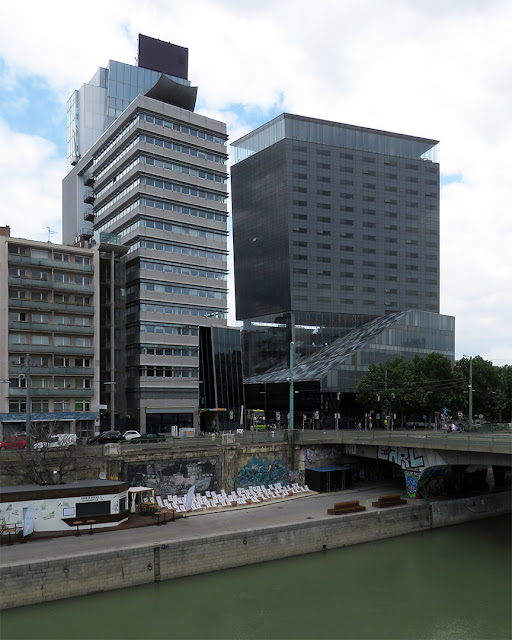Sunday, July 30, 2023
Saturday, July 29, 2023
Franz Lehár
Lehárdenkmal (Monument to Franz Lehár) by Franz Coufal, 1980
Stadtpark, Parkring
Vienna, June 2018
“Franz Lehár (30 April 1870 – 24 October 1948) was an Austro-Hungarian composer. He is mainly known for his operettas, of which the most successful and best known is The Merry Widow (Die lustige Witwe).” (Franz Lehár, Wikipedia)
Friday, July 28, 2023
Albero della vita
“Albero della vita” (Tree of Life) by Andrea Roggi, 2021
Via dei Georgofili
Florence, May 2022
“The leitmotif of Andrea Roggi's works, metaphorically represented by the Tree of Life, both in its iconographic meaning and as a symbol of plant life, is depicted by taking inspiration from the natural surroundings of his atelier in Castiglion Fiorentino, made of century-old olive and cypress trees. As human figures integrate with the plant forms, they fuse into a seamless whole imbued with a sort of magic realism, where the diverse elements blend together creating artworks dazzling with intricate detailing and charm. Through the iconography of the Tree of Life, Andrea Roggi communicates a sense of belonging to the native land.” (The Tree of Life, Andrea Roggi)
Thursday, July 27, 2023
Iglesia de San Nicolás de Bari
Frescoed vault by Antonio Palomino and Dionis Vidal, 1693
Iglesia de San Nicolás de Bari y San Pedro Mártir
Calle Caballeros / Plaza de San Nicolás
Valencia, September 2022
“San Nicolás de Bari and San Pedro Mártir is a Valencian Gothic style, Roman Catholic parish church located in Valencia (Spain). The church was founded in the 13th century, with a layout that includes a single-nave with six chapels between the buttresses and polygonal apse. The church was refurbished in Gothic in the 15th century, and includes a rose window alluding to a miracle of Saint Nicholas. There is an outdoor Chapel closed with a gate which is called the fossar, because there was before the parish cemetery. The other gate, which overlooks the square of San Nicolás, however, is a neo-gothic 19th-century recreation. The interior of the church was completed between 1690-1693, and was decorated by Juan Pérez Castiel in baroque fashion. It has frescoes, depicting the lives of San Nicola and Peter of Verona, along with virtues and allegories, designed by Antonio Palomino and completed by Dionis Vidal. The chapel altarpieces include works by Juan de Juanes, Fernando Yáñez de la Almedina, Jerónimo Jacinto de Espinosa, and José Vergara Gimeno.” (Church of San Nicolás, Wikipedia)
Wednesday, July 26, 2023
Tuesday, July 25, 2023
Coro de la catedral
Coro (Choir) by Rodrigo Alemán, 1498
Catedral de Toledo (Toledo Cathedral)
Calle Cardenal Cisneros
Toledo, September 2022
“Bishop Rodrigo Ximénez de Rada and those who followed him used master builders who had worked in or had experience designing in the French Gothic style. The cathedrals of Paris or Le Mans were their points of reference. The constructive solutions of the French Gothic builders were well-accepted, such as counter-rests, buttresses and pointed arches; nevertheless, the Spanish builders resisted the importation of the layout of the French cathedrals, where the choir and the altar were located in impressive sanctuaries, opting for smaller ones and situating the choir in the central nave. This was the syncretic solution of the Cathedral of Santiago de Compostela, which came first; all of this developed in Spain as much by the influence of the Mozarabic rite, as also by the Visigothic tradition and the Castilian liturgy. This historical evolution, combined with the status of the Primatial Cathedral, encouraged the adoption of the Toledan model by the rest of the Spanish cathedrals, with the exception of that of Burgos and that of León which more closely follows the French model. A similar arrangement of spaces can be seen in the cathedrals of Cádiz, of Seville, and of Palma de Mallorca, among others. And, as was foreseeable, the Spanish Empire carried the model of the Dives Toletana beyond, influencing those constructed in the Americas and the Philippines.” (Toledo Cathedral, Wikipedia)
Monday, July 24, 2023
Torch holder
Wrought iron torch holder
Via de' Tornabuoni
Florence, May 2022
“The external decoration of the Florentine palaces was very limited: the stone bench, the entrance gate with its studded doors, the wrought-iron lantern to be seen at the corners, the banner holders, the torch holders, the ringed hinges, again in wrought-iron, the family coat of arms.” (Torch-holder, Web Gallery of Art)
Sunday, July 23, 2023
Monumento a Felipe IV
Equestrian statue of King Felipe IV of Spain by Pietro Tacca
Plaza de Oriente
Madrid, September 2022
“The Monument to Felipe IV or Fountain of Felipe IV is a memorial to Felipe IV in the centre of Plaza de Oriente in Madrid, Spain. It was raised at the insistence of the portugueses in the first half of the 19th century, opening on 17 November 1843. However, its equestrian statue of the king dates to the 17th century and was produced by the Italian sculptor Pietro Tacca. It was begun in 1634 and shipped to Madrid in 1640, the year of his death. The sculpture, atop a complicated fountain composition, forms the centerpiece of the façade of the Royal Palace. The statue was based in drawings by Diego Velázquez and a bust by Juan Martínez Montañés (who also collaborated on the work). The daring stability of the statue was calculated by Galileo Galilei: the horse rears, and the entire weight of the sculpture balances on the two rear legs—and, discreetly, its tail— a feat that had never been attempted in a figure on a heroic scale, of which Leonardo had dreamed.” (Monument to Philip IV of Spain, Wikipedia)
Saturday, July 22, 2023
Friday, July 21, 2023
Puerta del Puente
Puerta del Puente (Gate of the Bridge)
Plaza del Triunfo
Córdoba, September 2022
“The Puerta del Puente (Gate of the Bridge) is a Renaissance gate in Córdoba, Andalusia. Built in the 16th century to commemorate a visit to the city by King Philip II, the gateway is located on the site of the previous Roman gates, linking the city with the Roman bridge and the Via Augusta. Since 1931, the gate, together with the Roman bridge and the Calahorra tower, has been declared a Bien de Interés Cultural in the monument category. It also part of the historic centre of Cordoba, declared a World Heritage Site in 1984.” (Puerta del Puente, Wikipedia)
Thursday, July 20, 2023
Tabernacle
Tabernacle by Giovanni della Robbia
Santi Apostoli
Piazza del Limbo
Florence, May 2022
“On the left of the apse are a polychrome terracotta tabernacle by Giovanni della Robbia. To right of the entrance is the tomb with the bust of Anna Ubaldi, mother of the Gran Priore del Bene, the bust was sculpted by Giovanni Battista Foggini.” (Santi Apostoli, Wikipedia)
Wednesday, July 19, 2023
Palacio Arzobispal
Palacio Arzobispal (Archbishop's Palace)
Plaza Virgen de los Reyes
Seville, September 2022
“The Archbishop's Palace of Seville (Palacio Arzobispal) is a palace in Seville, Spain. It has served as the residence of bishops and archbishops of the episcopal sees and numerous nobleman and military figures to the present time. It is located in the southern section of Seville, in the Plaza Virgen de los Reyes, angled almost opposite the Giralda. It is situated on the northeastern side of Seville Cathedral in the neighborhood of Santa Cruz. Of Spanish Baroque architectural style, it has had the status of National Monument since 1969.” (Archbishop's Palace, Wikipedia)
Tuesday, July 18, 2023
Monday, July 17, 2023
Dodekaederstern
“Dodekaederstern” by Herwig Hauser, 2013
Faculty of Mathematics, University of Vienna
Oskar-Morgenstern-Platz
Vienna, June 2018
“The sculpture ‘Dodekaederstern’ was constructed on the occasion of the reopening of the former PVA-building at Rossauer Lände in Vienna for the Faculties of Mathematics and Economic Sciences in 2013. The geometric figure is defined in all of its details by just one algebraic equation. Its star shape refers to the name of the Oscar-Morgenstern-Platz and it illustrates the interplay of various fields of mathematics such as invariant theory, algebraic geometry, and singularity theory.” (Dodecahedral Star, Dodekaederstern)
Sunday, July 16, 2023
Chapel by Bernardo Buontalenti
Chapel by Bernardo Buontalenti, 1580
Park of Pratolino, Villa Demidoff
Via Fiorentina, Vaglia
Florence, May 2022
“The Chapel was built in 1580 and is one of the last constructions made in Pratolino by Bernardo Buontalenti. Erected on the margins of the Park behind the Villa on an artificial earthwork mound, it can be reached by climbing up a staircase. It covers a total surface of 300 m2. Initially delimited by high firs, it is now surrounded by a broadleaf forest. The central-plan building was originally composed of a hexagonal room with a side of 4.20 m, surrounded by an ring-shaped porch of eighteen columns made of pietra serena (a grey Tuscan sandstone); four of them were later included in the walls forming the sacristy. Inside there are some pieces of furniture, among which the wooden stalls and the altar, with a big altarpiece and other decoration elements. The survey enabled to study the geometry of the dome (Arenga and Velatta 2012), coated with lead sheets and ending with a lantern, for a total height of 15.60 m., which in the previous surveys had been drawn only through patent approximations” (Geomatics for Knowledge and Conservation of Cultural Heritage: The Pratolino Park Case-Study, University of Florence)
Saturday, July 15, 2023
Village Underground Lisboa
Village Underground Lisboa
Avenida da Índia
Lisbon, April 2019
“Village Underground Lisboa is an international platform for creativity, art, and culture. It has an original architectural structure built with two buses and 14 shipping containers converted into multidisciplinary creative spaces where an artistic community resides. It has a restaurant and a sound recording studio. It hosts music, theater, cinema, and dance events with a focus on street culture.” (Village Underground Lisboa, Tripadvisor)
Friday, July 14, 2023
Thursday, July 13, 2023
Iglesia del Carmen
Iglesia del Carmen
Plaza del Carmen
Valencia, September 2022
“This architectural unit used to be part of the Carmelite convent and elements still remain from this time such as the cloister, with its pointed arches, the refectory and the conference room. The whole place was extended in the Baroque style; just next to the main entrance is the dome of the chapel of Nuestra Señora del Carmen, an oval-shaped temple designed by one of those responsible for bringing the neo-Classical style to Valencia, Vicente Gasco.” (Basílica de la Virgen de los Desamparados, Valencia City Guide)
Wednesday, July 12, 2023
Mugnone fountain
Mugnone fountain by Giambologna, 1577
Parco mediceo di Villa Demidoff
Via Fiorentina, Pratolino
Florence, May 2022
“Apart from Colossus of the Apennines, these include: the Fountain of Jupiter, the copy of which was installed by the Demidoff in the late 19th century; the hexagonal chapel with exterior loggia, in which the last Demidoff princess is buried; the Mugnone fountain, the statue for which was sculpted by Giambologna (1577); the Maschera fishpond, used also as a swimming-pool and adapted for hot baths; the large aviary; the pheasant house; Cupid's grotto, designed by Buontalenti in 1577; and the Neoclassical Montili lodge, built around 1820 by architect Luigi De Cambray-Digny. The park also contains centuries-old oaks, cedars and horse chestnuts, which are every bit as impressive as the man-made monuments.” (Parco di Villa Demidoff, Regione Toscana)
Tuesday, July 11, 2023
El Expolio
“El Expolio” (The Disrobing of Christ) by El Greco, 1579
Sacristy of Toledo Cathedral)
Calle Cardenal Cisneros
Toledo, September 2022
“The Disrobing of Christ or El Expolio (Latin: Exspolĭum) is a painting by El Greco begun in the summer of 1577 and completed in the spring of 1579 for the High Altar of the sacristy of the Cathedral of Toledo, where it still normally hangs. In late 2013 it was on temporary display at the Prado in Madrid (with the other El Grecos), following a period of cleaning and conservation work there; it was returned to Toledo in 2014. It is one of El Greco's most famous works. A document dated July 2, 1577 which refers to this painting is the earliest record of El Greco's presence in Spain. The commission for the painting was secured thanks to El Greco's friendship from Rome with Luis, the son of Diego de Castilla, the dean of the Cathedral of Toledo. De Castilla senior also arranged El Greco's other major commission, on which he worked simultaneously, the paintings for the Toledan church of Santo Domingo el Antiguo.” (The Disrobing of Christ, Wikipedia)
Monday, July 10, 2023
Sunday, July 9, 2023
Palacio Real de Madrid
Palacio Real de Madrid (Royal Palace of Madrid)
Calle de Bailén
Madrid, September 2022
“The Royal Palace of Madrid (Spanish: Palacio Real de Madrid) is the official residence of the Spanish royal family at the city of Madrid, although now used only for state ceremonies. The palace has 135,000 m2 (1,450,000 sq ft) of floor space and contains 3,418 rooms. It is the largest royal palace in Europe. The palace is now open to the public, except during state functions, although it is so large that only a selection of rooms are on the visitor route at any one time, the route being changed every few months. An admission fee of €13 is charged; however, at some times it is free. The palace is owned by the Spanish state and administered by the Patrimonio Nacional, a public agency of the Ministry of the Presidency. The palace is on Calle de Bailén (Bailén Street) in the western part of downtown Madrid, east of the Manzanares River, and is accessible from the Ópera metro station. Felipe VI and the royal family do not reside in the palace, choosing instead the Palace of Zarzuela in El Pardo.” (Royal Palace of Madrid, Wikipedia)
Saturday, July 8, 2023
Bench in a meadow
Bench in a meadow (with Gianna)
Park of Pratolino, Villa Demidoff
Via Fiorentina, Vaglia
Florence, May 2022
“The Park of Pratolino is one of the most beautiful parks in Florence surroundings. Even though the ancient Medicean villa and park has been destroyed, with just few monuments from that era remaining, it is easy to imagine its beauty and charm.” (Villa Demidoff, A Medici Villa, Discover Tuscany)
Friday, July 7, 2023
Triunfo de San Rafael
Triunfo de San Rafael de la Puerta del Puente
Plaza del Triunfo
Córdoba, September 2022
“The Triumph of San Rafael of the Puerta del Puente is one of the many existing triumphs in the city of Córdoba (Spain) dedicated to the archangel San Rafael , guardian angel of the city. It is located in the Plaza del Triunfo in the neighborhood of the Cathedral, within the historic center that was declared a World Heritage Site by Unesco in 1994, and very close to the Mosque-Cathedral, the Roman bridge and the Puerta del Puente.” (Triunfo de San Rafael, Wikipedia)
Thursday, July 6, 2023
Arco del Salvatore
Arco del Salvatore (Arch of the Savior)
Via Palestro
Massa, April 2022
“The Arch of the Savior is an ‘improper’ gate, probably replacing an older one, which, as shown by the seventeenth-century iconography, was unusually placed a little externally with respect to the wall perimeter. It is located on the western edge of the city route, and its original function remains uncertain. The architectural layout is dominated by a ‘rustic’ language characterized by powerful projecting ashlars; above the camber of the arch there is a marble coat of arms, also scalloped. The upper part is characterized by a thick gable on which the statue of the Savior rests centrally, attributable to a prestigious Carrara workshop of the late seventeenth century. On the sides stand four small pyramids, also in white marble like the large plaque that recalls the embellishment of the door by Carlo II Cybo, in 1690, probably precisely through the insertion of the aforementioned marble elements.” (Arch of the Savior, Massa Carrara Live)
Wednesday, July 5, 2023
Fuente-farola
Fuente-farola (Fountain-lamppost)
Plaza Virgen de los Reyes
Seville, September 2022
“Behind the cathedral in Seville you can find one of the prettiest and most iconic squares in the world, the Plaza Virgen de Los Reyes. With the fountain and baroque street light in the centre, and surrounded by exceptional buildings – the Cathedral and Giralda Tower, the Archbishop’s Palace, and the old Hospital of Santa Marta, it’s a hub of activity and a principal meeting place for both residents and visitors. During the day this is the main departure point for the horse drawn carriage rides; at dusk, come here to enjoy the deep, dark blue of the evening sky behind the Cathedral, and the wheeling and crying of the hunting swallows. Later, come to look at the Giralda lit up at night, a sight you won’t want to miss, and which never fails to take my breath away.” (La Plaza de la Virgen de Los Reyes, Seville Concierge)
Tuesday, July 4, 2023
Diamante
“Diamante” (Diamond) solar power plant, 2009
Park of Pratolino, Villa Demidoff
Via Fiorentina, Vaglia
Florence, May 2022
“The structure of a museum of contemporary art, seen from the outside, has geometric shape and sharp edges. It appears as a giant diamond of 42 faces and 12 meters high. It is a photovoltaic plant of a new generation recently introduced in the natural park of Pratolino near Florence which will illuminate the park as well as the great statue inside of it during the night. Some parts of the structure have been inspired by studies of Leonardo da Vinci. The appearance of the power station does not provide the artistic quality. The technology is not limited to simple photovoltaic which takes energy from sunlight and distributes it on the network. The plant contains within the structure in diamond-shaped three concentric spheres which through appropriate fuel cells act as an energy accumulator. The hydrogen is stored at low pressure and despite high cost of fuel cells, energy is available at any time.” (Solar power plant, Rober Glass)
Monday, July 3, 2023
Guitarra na Proa
Guitarra na Proa by Domingos de Oliveira, 2000
“Homenagem a Amália, o Fado e a Lisboa”
Avenida Brasília, Belém
Lisbon, April 2019
“Amália da Piedade Rebordão Rodrigues (23 July 1920 – 6 October 1999), better known as Amália Rodrigues or popularly as Amália, was a Portuguese fadista (fado singer). Known as the ‘Rainha do Fado’ (Queen of Fado), Rodrigues was instrumental in popularising fado worldwide and travelled internationally throughout her career. Amália remains the best-selling Portuguese artist in history.” (Amália Rodrigues, Wikipedia)
Sunday, July 2, 2023
Saturday, July 1, 2023
Sofitel Vienna Stephansdom
Generali Media Tower by Hans Hollein, 2000
Taborstraße
Sofitel Vienna Stephansdom by Jean Nouvel, 2009
Praterstraße
Vienna, June 2018
Subscribe to:
Posts (Atom)



